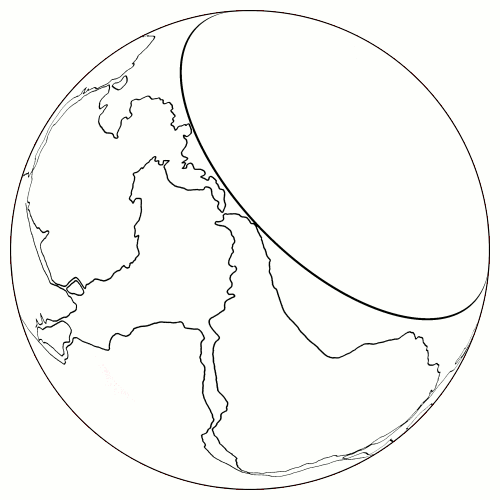Yes. It is not very well-explained. Here's (sort of) what I meant:The impacted area is contained within a circle on the globe (i.e., maps under a certain mapping, to a disk, and thus can be thought of as circular).
Therefore, the non-impacted area is also within a circle on the globe (i.e., maps under another, different mapping, to a disk, and thus can be thought of as circular).The first mapping referred to here is the azimuthal equidistant projection of PreEarth, with puncture point being the
center of the non-impacted region. It is the map you get when you put a small hole in the
centre of the non-impacted region and then stretch the planets skin to a flat disc.
Unfortunately, although this map projection shows that the impacted area can be thought of as circular, it is fairly misleading to even introduce it, as it is not necessary, the stated implication is not all that clear, and the map projection that we are really interested in is the one that is used in the AAPG map.
At some point I will rewrite the above post to remove this source of misunderstanding.
The mapping used in the AAPG sketch is the azimuthal equidistant projection of PreEarth, with puncture point being the
centre of the impacted region (i.e., the "opposite" of the one just mentioned). It is the map you get when you put a small hole in the
centre of the impacted region and then stretch the planets skin to a flat disc.
Under the AAPG mapping the non-impacted area (PreEarth-Pangea) maps to a disk and the impacted area maps to the annular area of ocean surrounding Pangea (as I stated on the other thread).
The AAPG circle corresponds to the boundary of the impacted and non-impacted regions.
Consider the following animation of PreEarth:

Under the AAPG mapping;
The impacted region, that which is within the ring in the above animation, maps to the annular area of ocean surrounding AAPG Pangea.
The non-impacted region, that which is "outside" the ring in the above animation, maps to AAPG Pangea.
The ring itself maps to the AAPG circle.
In the animation PreEarth-Pangea is pictured just as it fractures into continents, which then are expanded apart to their current positions on the newly renovated PreEarth (also known as Earth).
Is it clear now, why (under the collision theory) the boundary of Pangea must be circular?




